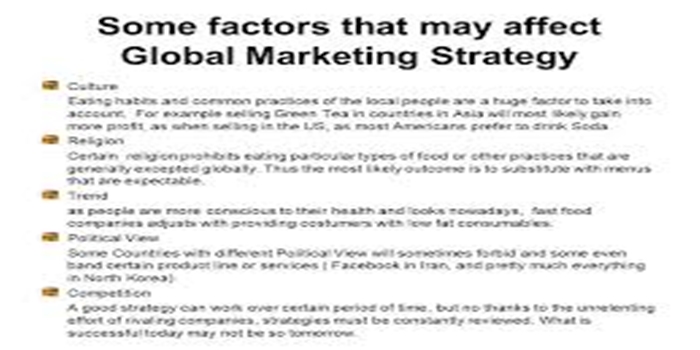In this article, we discussed the meaning of cultural factors in global marketing strategies, the examples, the factors, and benefits.
Definition
Cultural factors” in global marketing strategies refer to the values, beliefs, customs, and social norms of a particular culture that knowingly influence how consumers observe and respond to marketing messages, impacting the design and execution of marketing strategies when entering new markets across different countries or regions; essentially, understanding a target market’s culture is crucial to tailor products, advertising, and communication effectively to resonate with them.
Examples:
Language:
Translating marketing materials accurately and considering local dialects is crucial to avoid misinterpretations.
Values:
Understanding the core values of a culture, like individualism vs. collectivism, can influence how products are marketed and positioned.
Religious beliefs:
Marketing campaigns should be sensitive to religious holidays and practices to avoid offense.
Customs and taboos:
Certain colors, numbers, or symbols may be considered taboo in some cultures and need to be avoided.
Time perception:
“Past-oriented” cultures may value tradition and heritage while “future-oriented” cultures might focus on innovation, impacting marketing messaging.
Gender roles:
Marketing campaigns should consider the prevailing gender roles in a culture when designing advertisements.
Aesthetics:
Visual design elements like colors, imagery, and fonts should be culturally appropriate.
Social hierarchies:
Marketing strategies may need to be tailored to different social classes depending on the market.
Dietary restrictions
Colors: Understanding the symbolism of different colors in various cultures
Social norms: Adapting marketing messages to align with prevailing social values and behaviors
Gender roles: Considering how gender is perceived and represented in different cultures
Festivals and holidays: Leveraging culturally significant events for marketing campaigns
Cultural factors that significantly impact global marketing strategies include:
Cultural factors:
Understanding local customs, values, beliefs, and symbols is crucial to avoid misinterpretations and create culturally relevant marketing campaigns.
Economic factors:
Market size, income levels, currency exchange rates, inflation, and purchasing power directly affect product pricing and marketing strategies.
Political factors:
Government stability, trade policies, regulations, and political climate can impact market access and business operations.
Legal factors:
Advertising restrictions, consumer protection laws, labeling requirements, and intellectual property regulations vary across countries.
Technological factors:
Access to technology, internet penetration, and digital infrastructure influence marketing channels and consumer behavior.
Competitive landscape:
Analyzing competitors’ presence, market share, and strategies in different regions is essential for positioning and differentiation.
Language barriers:
Translating marketing materials accurately and considering linguistic nuances is vital for effective communication.
Demographics:
Age, gender, income distribution, and education levels within a market influence target audience segmentation.
Food and beverage marketing should consider dietary restrictions based on religious or cultural practices.
Business norms:
Understanding the appropriate business etiquette, like greetings, gift-giving, and negotiation styles, is essential for effective business interactions.
Key takeaway: To succeed in global marketing, companies must conduct thorough cultural research to adapt their strategies to the specific nuances of each target market, ensuring their marketing messages resonate with local consumers.
Values
Cultural values define what is good or desirable, and influence how people think, eat, and exercise
Language
Language is a system of communication that includes spoken and written words, body language, and slang
Norms
Social norms influence how people interact with each other and approach issues
How cultural factors impact organizations
IT solutions
Cultural factors can impact how IT solutions are chosen, how users are involved, and how procedures are organized
Economic change
Cultural factors can impact economic change by influencing how people perceive products and interact with each other.
Benefits of considering cultural factors in global marketing:
Improved brand perception:
By tailoring marketing materials to resonate with local cultural values, symbols, and language, companies can create a more positive and authentic brand image in the eyes of consumers.
Enhanced customer engagement:
When marketing messages are culturally relevant, consumers are more likely to engage with them, leading to higher levels of interest and potential purchase intention.
Increased market penetration:
By understanding and catering to different cultural nuances, companies can effectively expand their reach and access new markets across the globe.
Reduced marketing mishaps:
Avoiding culturally insensitive messaging or imagery can prevent negative backlash and damage to brand reputation.
Competitive advantage:
Companies that actively research and incorporate cultural insights into their marketing strategies can differentiate themselves from competitors who may not be as culturally sensitive.
Conclusion
Cultural factors significantly impact global marketing strategies by influencing consumer behavior, communication methods, and brand perception across different markets, requiring companies to adapt their marketing campaigns to local customs, values, symbols, and language to effectively reach and engage consumers in diverse cultural contexts; neglecting cultural sensitivity can lead to misinterpretations and damage a brand’s reputation.


